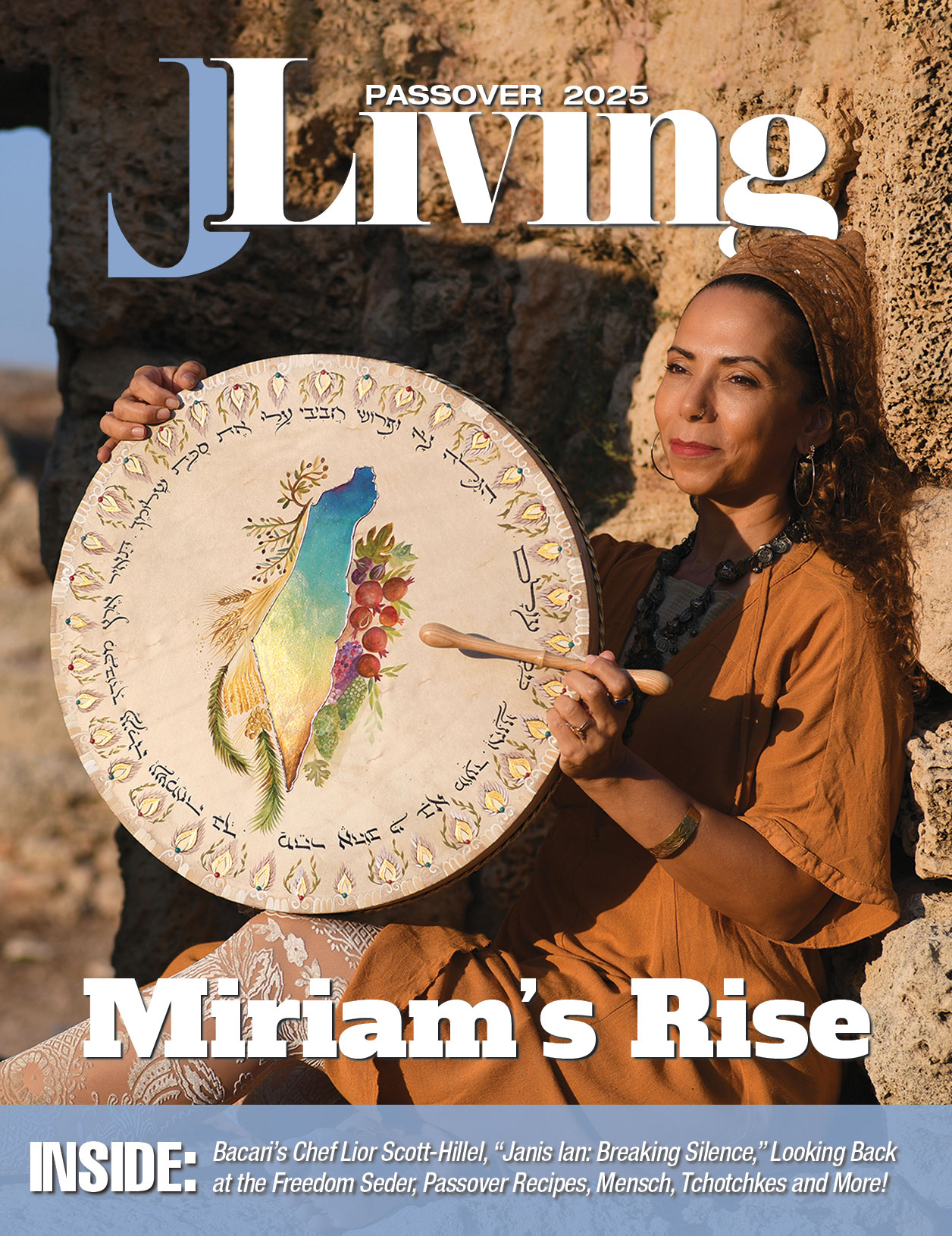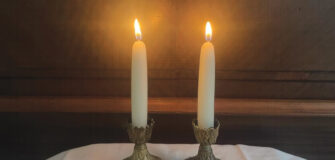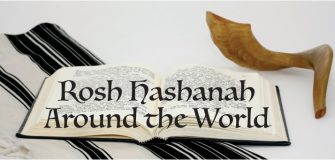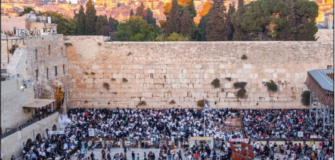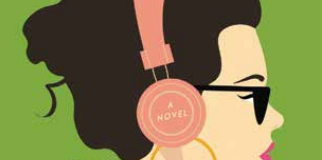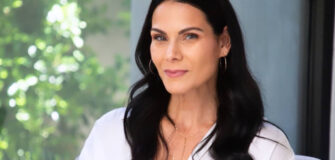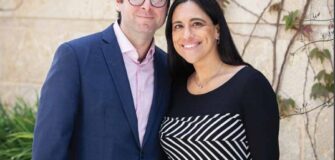BAT MITZVAH: 100 Years, Many Paths

When Jewish American children turn 13, they are traditionally called to the Torah for a Bar or Bat Mitzvah, often followed by a lavish reception. Yet, on March 18, 2022 – which happened to be the 100th anniversary of the first Bat Mitzvah in Jewish American history – Frieda Thompson finally had her turn. It also happened to be the day she turned 92.
Thompson is a survivor of the Holocaust and a beloved resident of the Los Angeles Jewish Home. Her parents were murdered by the Nazi, but Thompson recalls that – in the midst of the chaos during those dark days – her mother made sure that her brother was called to the Torah to become Bar Mitzvah.
Thompson had studied for the occasion a few years earlier, but COVID-19 interrupted her plans and the ceremony was postponed until her family and community were able to celebrate together. “Moses was loyal to his family and to the Jewish people,” she said on this very special occasion. “I too have always felt loyal to my family and the Jewish People.”
Congratulazioni! The earliest evidence of a bat mitzvah comes from Verona, Italy, in 1844. Throughout Jewish communities in the country, the tradition spread; when they turned 12, Jewish girls began to recite biblical verses before the Rabbi would deliver a sermon. The “iniziazione religiosa delle fanciulle” and “la maggiorita delle fanciulle” translates to an initiation into a minyan. Today, a Rabbi will assess a 12-year-old girl’s understanding of the faith, after which she will recite prayers in Hebrew and Italian with a celebration to follow.
Precisely 100 years prior to Thompson’s public commitment to her longstanding faith, 12-year-old Judith Kaplan broke new ground in American Jewish culture by becoming the first American girl to celebrate a Bat Mitzvah. Kaplan was the daughter of Rabbi Mordecai Kaplan, the Rabbi at the Society for the Advancement of Judaism and the founder of Reconstructionist Judaism.
Back then, in 1922, she did not read from the Torah. Instead, she recited the preliminary blessing, passage of the Torah printed in her Chumash, and the closing blessing. It was enough to shock even the members of her extended family. A first in America, but it took a while to really catch on.
In the 1930’s, a small percentage of Reform and Conservative congregations began to adopt the practice. It wasn’t until the 1960’s, though, that they really caught and became less of an anomaly and more universal.
As for Kaplan, she went on to have a d i s t i n g u i s h e d career teaching and composing Jewish music, authored several books on the subject, and even broadcasted her own radio series. Her work even included another first – a children’s American Jewish songbook that was published in 1937. In 1992, at the age of 82, she had a do-over – a second Bat Mitzvah ceremony. This time, she read from a Torah scroll.
One century after Kaplan’s first Bat Mitzvah, the practice has become commonplace in many sects of American Judaism. In most synagogues, hardly a weekend goes by without adolescents and preteens taking to the bimah in this comingof-age ritual. Kaplan started a new Jewish American tradition, one that opened up multiple pathways for girls and women across the United States to declare their commitment to their faith.
In the modern synagogue, aspiring Bat Mitzvahs begin attending Hebrew school long before their thirteenth birthday. They commonly spend several years attending weekly classes to learn about what it means to be a Jew. As the ceremony approaches, they begin practicing their Torah portion with the Rabbi or Cantor, write a speech, and choose a mitzvah, a good deed, that is meaningful to them.
This modern approach was much the case for Randi Pearlman, who came of age attending Hebrew school at the Reform temple her family belonged to. It was the late 1980s, and Pearlman recalls neither looking forward to or dreading going to classes each Sunday. “I don’t think I ever questioned it,” she says. “It was just what the kids did in my family and in that community. We went to classes, learned our Torah portions, wrote our speeches, and planned our parties.” She has fond memories of what she called the Bar/Bat Mitzvah circuit – the year that almost everyone in her class turned 13 and all of the festivities that ensued on a near-weekly basis.
In the Hebrew Bible, it is said that 70 is the number of years that a person may expect to live. Based on this logic, a newer ritual is catching on for Jews who have reached the age of 83. They may choose to celebrate a second Bar or Bat Mitzvah to commemorate the full lifetime they have lived since committing to their faith at the age of 13. As people continue to live longer and healthier lives, this practice may increase in popularity.
At that age, Pearlman says she failed to appreciate that this ‘tradition’ had in fact only been a tradition for 67 years, a mere fraction of time compared to all of Jewish history that had come before. “Like voting, like going to college, like having a career – I had no idea back then of all the things that had to happen before in order for me to have not just an opportunity, but an expectation of experiencing these important things that make me who I am today.”
While modern American girls typically become bat mitzvah at age 13, many of the related traditions in Jewish history refer to girls taking on the responsibility of adults at the age of 12, which is when Judith Kaplan celebrated hers. In fact, the phrase bat mitzvah makes just one appearance in the Talmud, referencing the age at which a girl becomes obligated to the Jewish laws that apply to adults. The age for boys is similarly referenced as 13.
For Pearlman’s mother, Anne Hartman, it was a different time when she was growing up. Therefore, she took a very different path to become Bat Mitzvah. Born in 1947, just 25 years after Kaplan became the first American Bat Mitzvah, Hartman says they simply weren’t common for girls her age in the boroughs of New York City, at least not in her neighborhood.
Hartman’s mother was Jewish, and though her father wasn’t, she was raised in the Jewish faith, keeping traditions around the holidays. “As a teenager, I went with my friends to temple on the high holy days,” Hartman remembers. “We also celebrated Passover at my aunt’s house, but otherwise, we didn’t belong to a temple.” Neither she nor her older brother attended Hebrew school and they were not called to the Torah either.
Then something unexpected happened. In 1994, just five years after her daughter’s ceremony at the local synagogue, Hartman went on a trip to Israel. During a tour of Mount Scopus, she and her cousin were offered an opportunity to become Bat Mitzvah.
Like Kaplan at her first Bat Mitzvah, they did not read from the Torah. Instead, they were taught a prayer to recite. It was a simple ceremony that Hartman found quite meaningful. “I was moved by it,” she says.
Women and girls of every generation in the last 100 years have taken various routes to the beautiful Jewish initiation ceremony. For many, like Pearlman, it is all part of coming-of-age in the synagogue and as much an expectation as going to grade school. Others, like Thompson and Hartman, find their way later in life, sometimes without even expecting it.
It would be remiss to leave out the extravagant nature of a modern Bat Mitzvah. In many families, as much (if not more) attention may be paid to the post-ceremony celebration. From dress shopping, invitations, guest lists, and party favors to the choice between a band or a DJ, these special occasions can often rival a wedding in the level of detail, luxury, and cost.
It can be a far cry from a simple celebratory meal with friends, family, and neighbors that Kaplan probably enjoyed. Even Pearlman, whose event took place in 1989, recognizes how much they have changed over time. She has been in awe of the spectacles she has witnessed at the Bat Mitzvahs of her younger cousins in the last two decades. For her own children, Pearlman imagines a more modest event will suit the family’s tastes and budget when the time comes; she also knows her mother might have an opinion on the subject.

